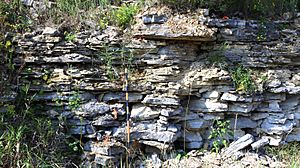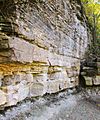Platteville Limestone facts for kids
Quick facts for kids Platteville LimestoneStratigraphic range: Ordovician |
|
|---|---|

Platteville Limestone exposed in Decorah, Iowa
|
|
| Type | Formation |
| Underlies | Decorah Shale |
| Overlies | Glenwood Formation |
| Location | |
| Country | United States |
| Extent | Upper Midwest |
| Paleozoic Stratigraphy of the Upper Midwest, USA Dates are approximate, and deposition occurred at slightly different times in different areas |
|---|
Ordovician
|
The Platteville Limestone is a type of rock found in the upper Midwestern United States. It's a gray, rough limestone that formed a very long time ago, during the Ordovician Period. You can find many fossils inside it! This rock is named after Platteville, Wisconsin, where it was first studied.
In the early days, Platteville Limestone was often used to build important cities like Minneapolis–Saint Paul and Faribault, Minnesota. In Illinois, this rock layer is known as the Platteville Group.
Contents
How Platteville Limestone Formed
Like most limestones, Platteville Limestone was created in the ocean. This happened between 488 and 436 million years ago. Back then, the area that is now southeastern Minnesota and southwestern Wisconsin was covered by a deep, ancient sea.
Sea Life and Rock Formation
This ancient sea was full of sea creatures like shellfish and other animals without backbones. When these creatures died, their shells and hard parts, made of a material called calcium carbonate, sank to the bottom of the ocean. Over millions of years, more and more of these shells piled up. The weight of these layers pressed the shell pieces together, turning them into the hard rock we now call Platteville Limestone.
Below the Platteville Limestone, you can find a thin layer called the Glenwood Shale. Underneath that is a thick layer of St. Peter Sandstone. The Platteville Limestone also has swirly patterns of a mineral called dolomite. This dolomite formed in the rock after it was first laid down, but before cracks appeared in it.
After the Sea: Glaciers and Rivers
About 100 million years after the limestone formed, the land in southeastern Minnesota slowly rose above the ocean. In the area that became the Twin Cities, the limestone was covered by thin layers of shale and soil.
Much later, huge sheets of ice called glaciers covered this region. This was from about 75,000 to 12,000 years ago. When these glaciers melted, between 14,000 and 12,000 years ago, a lot of water was released. This water carved out the channels for big rivers like the Mississippi and Minnesota, and smaller rivers too. As the rivers cut through the land, they exposed some of the Platteville Limestone.
This tough rock forms the top of famous waterfalls like Saint Anthony Falls and Minnehaha Falls. It also makes up the tall bluffs along the Mississippi River in the Twin Cities area. Many fossils of ancient sea life can be found in the limestone here. These include corals, bryozoans, brachiopods, clams, snails, cephalopods, and trilobites.
How Platteville Limestone Was Used
Platteville Limestone was a popular building material in the 1800s because it was easy to find and quarry.
Building Fort Snelling
In 1820, the United States Army started building Fort Snelling. The fort was located right on top of a large deposit of Platteville Limestone. This rock is easy to break into pieces, making it simple to quarry. Soldiers used Platteville stone to build almost the entire original fort, from its foundations to the round tower. Fort Snelling is still the largest group of buildings ever made from Platteville stone.
Constructing Cities
Just like Fort Snelling, downtown Saint Paul was built on a layer of Platteville Limestone. Once the city started replacing its early wooden buildings, this local stone became very important. The first quarry for Platteville stone in Saint Paul opened in 1856.
Many famous buildings in Saint Paul were built using this stone. These include the Original Coney Island (built in 1858), the Alexander Ramsey House (1868), and the Church of the Assumption (1874). You can also see beautiful examples of Platteville limestone in private homes in Saint Paul's Summit Hill area, like the Burbank–Livingston–Griggs House (1862).
Platteville stone was also quarried and used in Minneapolis. However, fewer buildings made of it have survived there into modern times. Quarrying began in Minneapolis in 1864. Builders used it for the original Customs House and City Hall (both 1873) and the first Central High School (1878). One of the most famous remaining examples is the ruin of the Pillsbury A-Mill, built in 1881. Its walls are all made from Platteville stone that was quarried right at the building site.
Use Outside the Twin Cities
Outside of Minneapolis and Saint Paul, Platteville stone was also used for other important buildings. Carleton College's first permanent building, Willis Hall (1872), was made from Platteville stone quarried nearby in Dundas, Minnesota. In Faribault, the Cathedral of Our Merciful Saviour, Bethlehem Academy, and most of the main buildings at Shattuck-Saint Mary's were also built with Platteville. The stone in this area often looks a paler gray, sometimes with light brown spots.
Why Its Use Declined
Platteville Limestone was mainly popular because it was easy to find and often available right where people were building. However, it had some downsides. It was coarse and crumbly, meaning it couldn't be carved or polished to a smooth, fancy finish. Its gray color also wasn't always preferred.
By the 1870s, railroads made it easier and cheaper to bring in other, more attractive building materials. These included the red Lake Superior Sandstone and the buff-colored Kasota limestone. These stones were prettier and easier to work with. Because of this, builders rarely used Platteville Limestone for big projects after the 1880s.
Images for kids
-
The Platteville Limestone cropping out in Minnehaha Park, Minneapolis. The Platteville Limestone is the less-eroded, layered unit that constitutes the majority of the photo. Below it is a thin, dark layer of Glenwood Shale. Below the shale is a thin, white stripe of St. Peter Sandstone, followed by a slope of eroded St. Peter Sandstone material.


